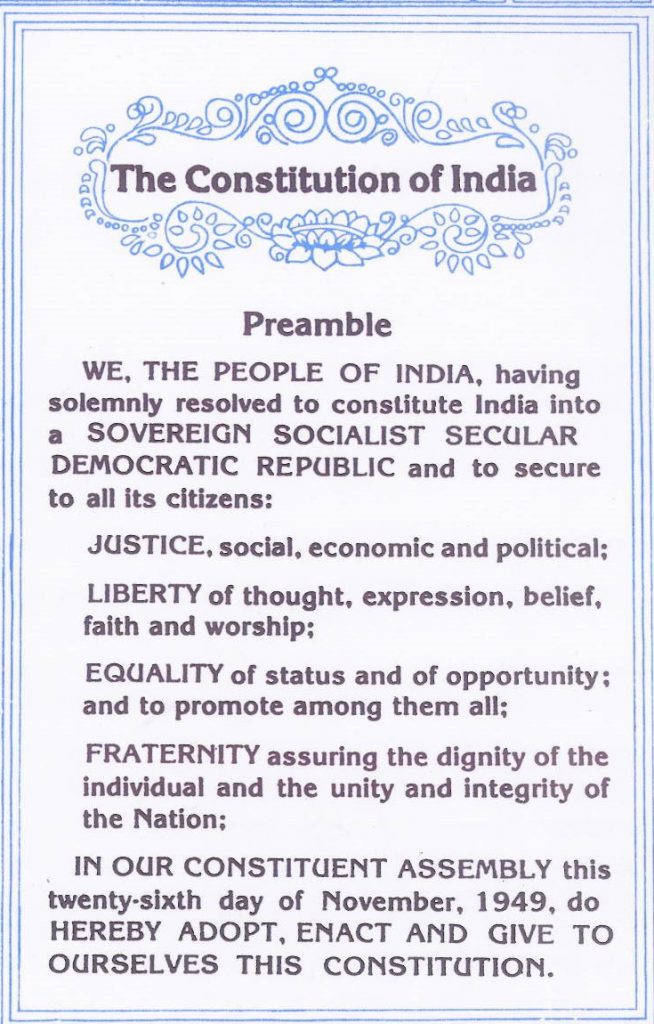|
For those who will rather listen
|
Do you know India is the largest democracy in the whole world?
How does India operate, given that its major geopolitical, regional, lingual, cultural differences?
It operates on democratic principles.
How does a democracy work anyway?
The constitution guides democracy to function.
Let’s start with reading the preamble.:
Indian Constitution Preamble
If there is one picture that gives goosebumps, it has to contain the preamble of our constitution:

Our ancestors fought hard (and bravely) for it, and we won’t ever let them take it away from us.
Let’s understand our democratic system in 9 points:
A) Voting
We the common people vote for three different elections. Our votes decide Municipal Leader at the district level who takes care of basic needs of our city such as infrastructure and transportation.
MLA at the state level takes care of the “implementation of laws” made by MPs and also has a say on state-specific bills made by the State government.
Third, MPs at the national level. They become members of our parliament. Our MPs have no responsibilities and allotted tasks except representing demands and needs of their seat-specific location when a bill is being discussed by actively debating on the bills.
B) Bills
In a given constitution, to maintain relevance and fulfill the needs of people/country, we need to constantly have new bills. There’s a legitimate system to make a bill law.
First, someone from the cabinet minister proposes a bill. Then it is exposed to the public to have a public opinion. Then it is discussed by all members of the cabinet. The cabinet is selected by the PM, it is a group of ministers who handle different ministries for our country.
Once approved by the cabinet it is presented in LokShabha. If it gets approved by LokShabha, it is passed on to RajyaShabha. If RajyaShabha suggests correction, then the bill again has to go through LokShabha.
C) Speakers
There are question hours, where parliament members get to ask questions on bills. And govt. must answer them all.
However, if any minister still has not satisfied he may give zero hour notice to the speaker, where he gets to ask questions. However, government has no ‘obligation’ to answer the question raised in zero hour.
You ask how much times allotted to parliament members to speak? It’s simple, the largest party MPs get the first chance and more time to speak. It can get as low as 2 minutes for smaller party MPs as it happened with Asaduddin Owaisi.
D) Committees
67 days/year is the average time of parliament operations. If there is a major protest against a bill, the speaker sends them to committee members – consisting of a randomly selected group of employees. Committee meets in private & dissent statements can be written. MPs can have their say without reliving their identity. These committees are important to hold the cabinet accountable to ‘parliament.’
E) Budget
We often see budget “full” coverage on TV channels where the financial minister narrates it. Apparently, that is a super concise and “selective” part of the budget we are usually exposed to. For example, once the real budget was 923 pages long, but what we heard on TV was only 58 pages.
When taxes are collected from us, it goes in Consolidated Fund of India. From there a part of it gets distributed to state governments. There is also a whole process through which a budget has to go through. Watch this clip to explore that.
If you are still reading it, before moving to F, I must warn you about TRIGGER.
F) Anti Defection Law
The point of democracy was to make sure every voice is heard and considered in policymaking. Anti defection law exactly takes it away from us indirectly and from parliament members directly.
According to this law, a parliament member from a particular party CANNOT dissent to it. It means if the party leader tells its MPs to speak in favor of a particular bill, they all have to obey. Otherwise they ‘constitutionally’ get fired from the MP position.
This is as true as this is shitty. Moreover, every party gets to select a ‘whip.’ A whip’s job is to communicate the Party stand to all members and make sure that every member votes according to the orders.
Infuriated? Warned ya.
G) Private Member Bills
It is a great tool for individual parliament members to propose their own bills. However, only 14 bills managed to pass through both LokShabha and RajyaShabha to the date.
Two recent private member bills presented by members worth discussing are 1. Homogenous gender marriages proposed by Mr. Shashi Tharoor & 2. Transgender rights bill proposed by Mr. Tiruchi Siva. The Transgender Rights Bill in fact got passed from LokShabha. This is a must-watch to see how valiantly Tiruchi Shiva proposed the bill and did something out of the box.
We have discussed enough “Legislative” pillar of democracy. Now it’s time to explain the second piilar of democracy that is, EXECUTIVES. They are civil servants.
H) Bureaucrats
Though bureaucrats are actually the people who run the nation, actionably speaking. As they IMPLEMENT all the policies. This is a huge service and we must celebrate them.
Except there’s an Article 311 in our constitution. Article 311 says that no government employee either of an all-India service or a state government shall be dismissed or removed by an authority subordinate to the own that appointed him/her.
That means there is a lot of crime and corruption, but they can’t be removed. Moreover, there are no performance assessments of their work.
Now the third and final pillar of our dear democracy:
I) Judiciary
Judiciary has the responsibility of upholding the laws as well as interpret the laws. It cannot make the laws, however. The hierarchical system of judiciary works like this:
Supreme Court is the supreme no one gets to question decisions of the supreme court except the Parliament. This way balance of power remains intact between these two pillars.
Then comes High Courts – state-level supreme. Then District Courts. There are Tribunals too, they are not so much as hierarchical but they are special courts with specific cases to resolve. One example of these is Telecom Disputes Settlement & Appellate Tribunal.
I hope you’ve had a great time learning about our democratic structure and its elements. I tried my best to provide the education in as few words as possible.
Again the soul of The Awakened Youth is the rebel against injustice and human rights. The purpose of educational pieces like these is to empower our readers to KNOW the system. You can’t fight what you don’t understand – not effectively.
Share it with UPSC Aspirants, share it with the people who want to fight the system, share it with your uncles, and share it with everyone who you think needs to read this.
PS: I’ve tried my best to be as accurate and authentic as possible. I’d love to get correction comments however if you find any. This piece is based on the educational video series by Newslaundry called “Consti Tuition.” Highly recommend the series; you can find it on YouTube.
See ya in our upcoming battle! 🙂


Pingback: Inhumane and Spineless Attacks on Journalists and Abdul Sadam – The Awakened Youth
Pingback: Defection, Internal Party Conflicts, and Their Potential Harms! - The Awakened Youth
Pingback: How exactly does India function Part-2 - The Awakened Youth